Shopify JSON was first introduced as part of Shopify’s Online Store 2.0 update to revolutionize the way merchants design and manage their storefronts. Before JSON templates, Shopify relied predominantly on Liquid templates (a template language created by Shopify), which are powerful but less flexible for customization and layout management without coding.
JSON templates were created to provide merchants and developers with a more modular and user-friendly way to build pages by customizing sections directly through Shopify’s theme editor. As eCommerce continues to evolve, understanding how to use Shopify JSON can unlock new ways to tailor user experiences and streamline store management.
This blog will guide you through the basics of what Shopify JSON is and provide practical steps to create and use JSON templates effectively.
What Are Shopify JSON and Shopify JSON Templates?
What is Shopify JSON?
Shopify JSON (JavaScript Object Notation) is a lightweight data format used within Shopify’s ecosystem to structure information dynamically. It helps Shopify store information in a clear and easy-to-read way.
What are Shopify JSON templates?
A Shopify JSON template is a special file that controls how different parts of a page are arranged on your Shopify store pages. Instead of needing to write complex code, you can easily add, remove, or move sections right from the Shopify theme editor. They are ideal for quickly changing layouts and page designs to different products, collections, or marketing campaigns.
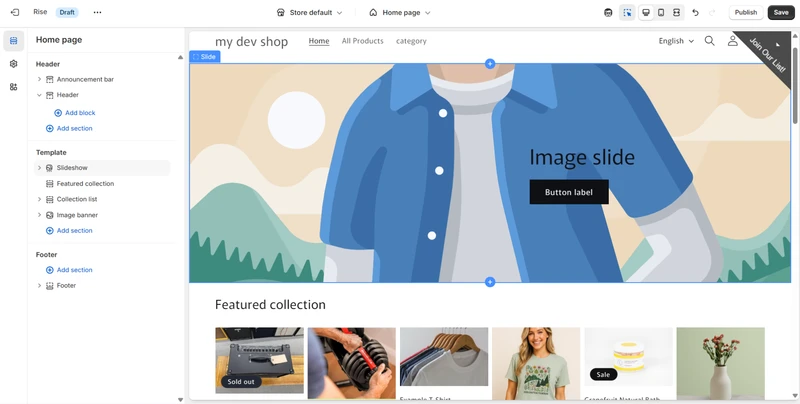
JSON is a lightweight data format, which means it requires less storage space and bandwidth, allowing data to be transmitted quickly over the internet. That’s why JSON templates get faster loading times for websites and applications. This is helpful for stores with large product and variant inventories that might slow down page speed.
Read more: How Many Products Can You Have on Shopify? – Full Breakdown
Because JSON templates support modular editing and app integration, they are especially beneficial for stores using Shopify Online Store 2.0 themes. Whether you want different product pages for various product types or promotional pages that change with the seasons, JSON templates make it simple to create unique, dynamic layouts.
Additionally, these templates help reduce clutter by storing their own settings data, making store management cleaner and more efficient. Overall, JSON Shopify templates are a great choice for merchants who want to take full advantage of Shopify’s latest theme features and performance improvements.
What are the benefits of Shopify JSON templates?
Using JSON templates provides several advantages:
- Flexibility: Easily create dynamic page layouts tailored to different product types or marketing campaigns.
- Performance: JSON templates can improve page load times by structuring data efficiently.
- Customization: Merchants gain more control over the storefront experience without extensive coding.
- Integration: Smoothly work with Shopify APIs and third-party apps for more complex tasks like importing reviews, discount codes, metafields,…
How Are Shopify JSON Templates Different from Liquid Templates
Shopify offers two main template formats for building and customizing storefronts: JSON and Liquid. While both serve the purpose of shaping how your store looks and functions, they differ significantly. Understanding these differences helps merchants choose the right approach.
| Feature | JSON Templates | Liquid Templates |
| Purpose | Easily add, remove, and rearrange page sections | Add complex logic and dynamic content |
| Flexibility | High flexibility for layout changes | Very flexible but requires coding |
| Performance | Usually faster to load | Can be slower depending on the code |
| Use Case | Flexible storefront design and API integration | Complex logic, detailed content manipulation |
| Coding | Generally easier for layouts | Requires deeper coding understanding |
Shopify JSON templates focus on easy, modular layout customization, while Liquid templates provide more powerful coding flexibility for dynamic content.
How to Create Shopify JSON Templates in 4 Steps
Creating a JSON template allows you to build customizable and flexible store pages that can be easily managed through the Shopify theme editor.
Here’s a detailed guide to help set up your own JSON template in Shopify:
- Step 1: Create a new JSON template file
- Step 2: Build your templates in Theme Editor
- Step 3: Assign your JSON template to a resource
- Step 4: Preview and refine your template
Step 1: Create a new JSON template file
The first thing you need to do is navigate to Online Store > Themes in your Shopify Admin. There, find the theme that you want to edit, click the three dots, and select Edit code in the dropdown list.
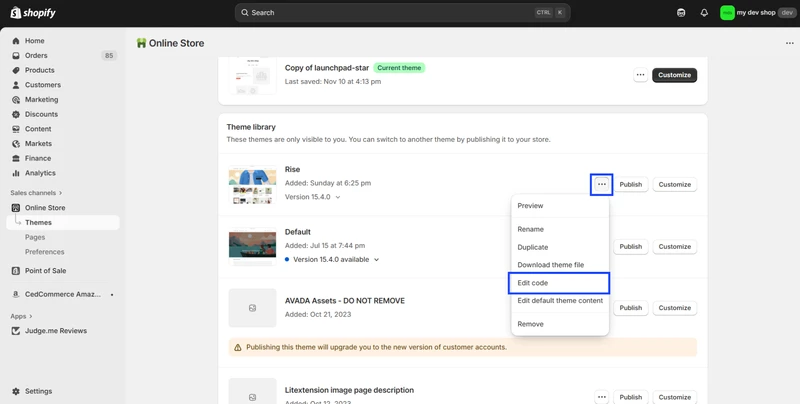
This opens the theme’s code editor, where you can create and modify theme files.
Here are the theme file types you can create in Shopify using JSON templates:
| Type | Description |
| 404 | Shows a “Page Not Found” message when visitors enter an invalid URL. |
| article | Displays a single blog post, with optional comments. |
| blog | Lists all blog posts within a specific blog. |
| cart | Shows the shopping cart with all items a customer has added. |
| collection | Displays all products in a specific collection. |
| list-collections | Shows a list of all collections in your store |
| customers/account | Overview page for a logged-in customer’s account. |
| customers/activate_account | Page for new customers to activate their account. |
| customers/addresses | Let customers view, add, and manage shipping addresses. |
| customers/login | Login form for customer accounts. |
| customers/register | Sign-up form for creating a new customer account. |
| customers/reset_password | Form for customers to reset their password. |
| customers/order | Displays details of a customer’s past orders. |
| index | The main homepage of your store, located at the root URL (/). |
| page | Standard shop pages (e.g., About Us, Contact Us). |
| password | Landing page shown when the store is password-protected. |
| product | Shows details of a single product (images, description, add-to-cart). |
| search | Displays search results for products or content. |
| metaobject | Renders special pages for custom data types (e.g., artists, authors). |
Inside the code editor, locate the Templates folder. Here, create a new template by clicking the New file icon. Give your file a name following one of the types above to keep things organized and save it with the filename extension .json (e.g., product.demo.json).
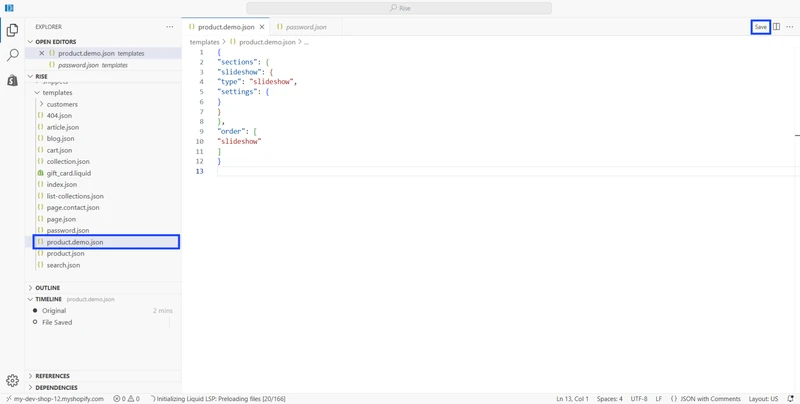
In your new JSON template file, Shopify will automatically create a default code snippet for you. To make the template function properly, you’ll need to remove it and paste the following code instead:
{
"sections": {
"slideshow": {
"type": "slideshow",
"settings": {
}
}
},
"order": [
"slideshow"
]
}
This code snippet provides a simple JSON template structure by creating a slideshow section on your page. After adding the code, click Save.
Step 2: Build your templates in Theme Editor
Once you’ve created your JSON Shopify template, you can use it as a foundation to build additional templates directly in the theme editor. To get started, in your Theme page, click the Customize button next to your theme to open the Theme Editor.
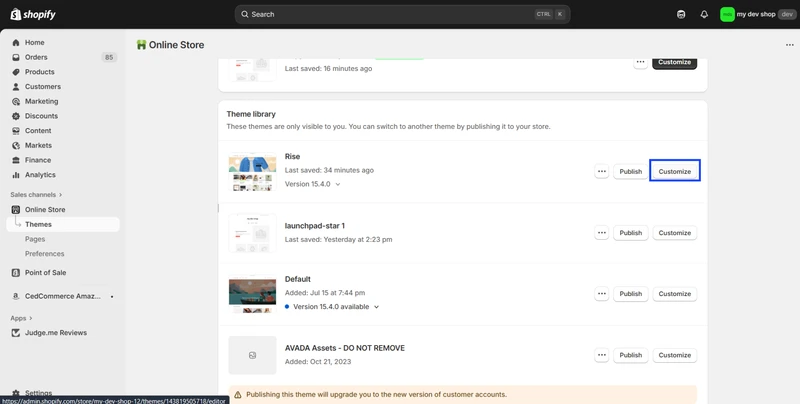
On the header of the Theme Editor, there is a center menu that shows the template you’re currently editing. When you first open the editor, this menu displays Home page as the default. You need to press it and choose the template you want in the drop-down menu. In this example, select Product and choose Demo.
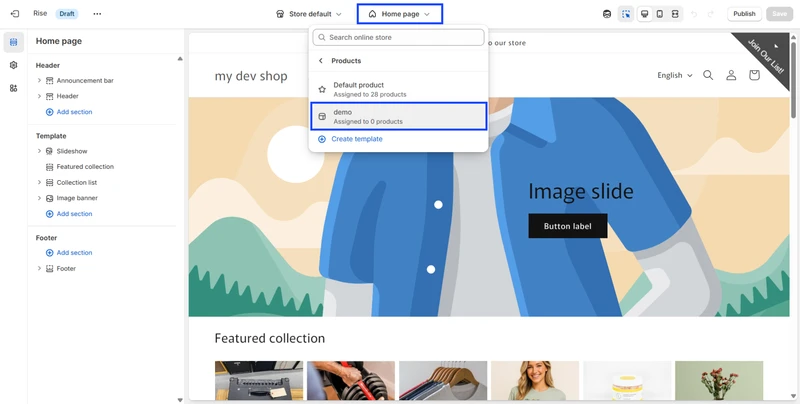
Here, you can customize the template to suit your specific needs. You can add, move, or remove sections all across your template. After customizing, you can save your template layout and publish it to your store.
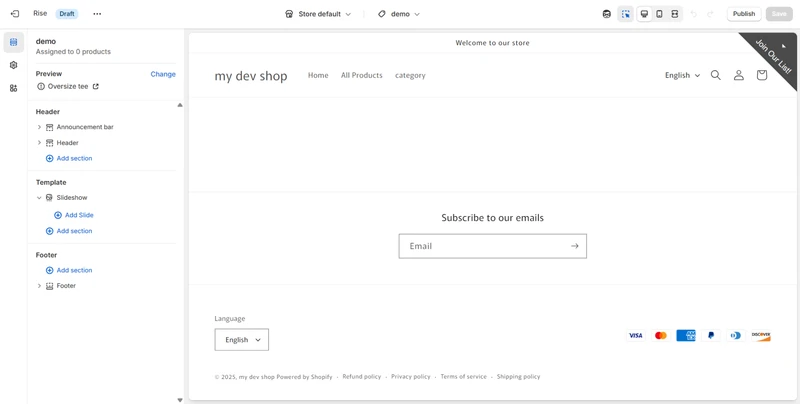
To add more templates from your newly created template, choose Create template in the center menu (now displayed as demo), enter a name, and choose to base it on your demo template.
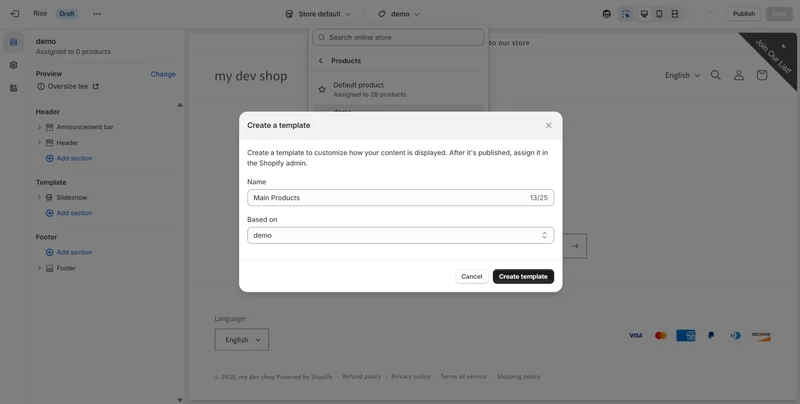
Step 3: Assign your JSON template to a resource
Once your JSON Shopify templates are ready, go back to your Shopify admin and open the resource you want to customize. Under the Theme templates dropdown, select your new JSON template. This assigns the layout you created to that specific resource.
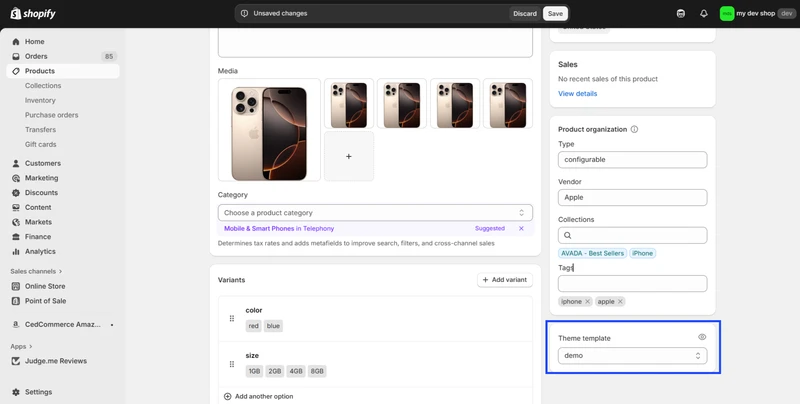
In this example, to apply product.demo.json to a specific product, navigate to Product, open the product you want, and select ‘demo’ as the template.
Step 4: Preview and refine your template
When you’re done, visit your storefront and check how the JSON templates look in action. Also, you should remember to test on different devices to ensure responsiveness and usability.
If anything looks off or you want to add features, return to the code editor and adjust the Shopify JSON accordingly until you achieve the perfect layout.
How to Retrieve JSON Data from Shopify
JSON data from Shopify is simple and useful for detailed store information, like products or collections, in a structured format. Here are the steps to retrieve Shopify JSON data:
- Step 1: Identify your API URL
- Step 2: Access the JSON data in your browser
- Step 3: Interpret and use the JSON Data
Step 1: Identify your API URL
Shopify provides a REST API endpoint that lets you access data in Shopify JSON format. For example, to get product data, you append /products.json to your store’s base URL. If your store URL is https://yourstore.myshopify.com, you visit https://yourstore.myshopify.com/products.json to see JSON data about your products.
Step 2: Access the JSON data in your browser
To access Shopify JSON data, first, log in to your Shopify admin and open a new browser tab. Here, you need to type your store’s URL followed by the relevant .json endpoint, such as /products.json, /collections.json, etc., and hit Enter.
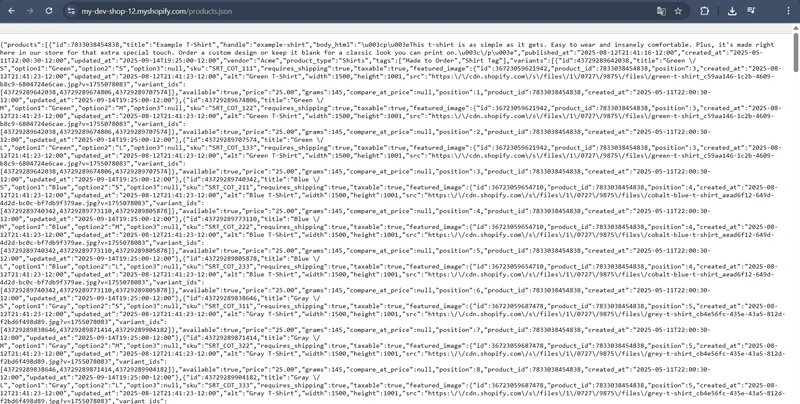
This will display raw JSON data on your screen containing detailed information about products, collections, and other data types.
Step 3: Interpret and use the JSON Data
In the URL, you can see a structured JSON object containing the requested data. You can use this JSON directly for building customized storefronts, importing into apps, or feeding to external systems.
Common Use Cases for Shopify JSON Templates
Shopify JSON is highly versatile and can be used to create customized and dynamic pages across your store. Here are some common and easy-to-understand use cases:
- Different page types: You can create unique JSON templates for various page types like product pages, blog posts, or collection pages. This lets you design each page type to best showcase its content, such as highlighting product features on product pages or displaying blog content elegantly.
- Alternate templates for the same page: Suppose you want certain products shown with a video demo while others use image galleries; JSON templates let you create different layouts for the same page type. You can assign these alternate templates to different products or pages, tailoring the shopping experience.
- Context-specific templates: Shopify JSON can adapt based on specific buyer contexts. For example, create a holiday sale template with festive banners or a luxury theme template for high-end products. This customization helps engage different customer segments effectively.
Best Practices for Using JSON Templates in Shopify
To make the most out of JSON Shopify templates, following these practices ensures your store remains flexible, maintainable, and optimized for performance:
- Combine JSON with Liquid: While JSON templates handle layout well, Liquid is still essential for dynamic content and complex logic. You can use Liquid for tasks like conditional displays, loops, or data manipulation paired with JSON templates for layout control.
- Test across different devices: You should always preview and test your JSON templates on different devices and browsers. Responsive design ensures your store looks great and functions smoothly on desktops, tablets, and smartphones.
- Leverage Shopify’s default and apps: You can incorporate Shopify’s native sections and compatible app sections within your JSON templates to add functionality without custom coding. This streamlines development and ensures compatibility with updates.
- Regularly update and maintain: Store owners should always stay updated with Shopify’s latest theme development guidelines and JSON template features. These regular maintenance ensures your templates leverage new capabilities and remain secure.
Shopify JSON – FAQs
Do JSON templates replace Liquid in Shopify?
JSON templates complement Liquid by handling layout and structure, but Liquid remains crucial for complex logic and dynamic content rendering.
Can I mix Liquid and JSON on the same page?
Yes, Shopify allows combining Liquid’s powerful templating with JSON for flexible design and functionality.
Can I assign different templates to different product types?
Yes, you can assign different templates to different product types in Shopify, as long as the templates are within your current theme. Simply go to each product’s settings in the Shopify admin, find the Template section, and select a template for that product.
Where do I see JSON data on my storefront or API?
You can see Shopify JSON data on your Shopify storefront in the template files stored in your code editor. Additionally, you can view raw JSON data on your Shopify store by adding .json to your store URLs like /products.json or /collections.json.
Conclusion
Shopify JSON is a powerful addition to the Shopify ecosystem, offering merchants and developers new ways to customize their stores efficiently and effectively. By understanding how to use Shopify JSON, store owners can build dynamic, scalable, and engaging online shopping experiences that stand out in today’s competitive market.
Take the next step in unlocking your store’s full potential – start experimenting with Shopify JSON templates today. With the right approach, you’ll build a more engaging and dynamic shopping experience that drives sales and grows your business.




